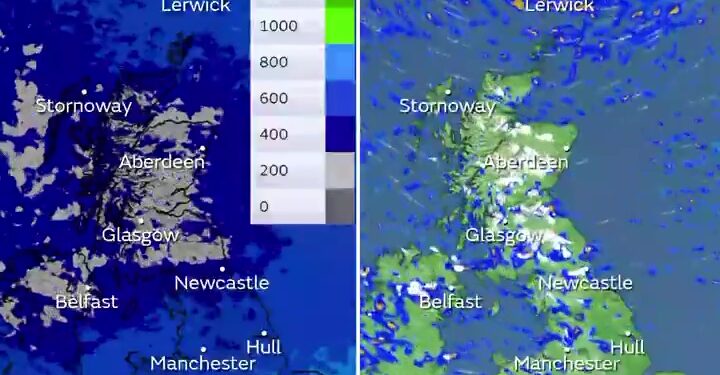A NEW map has revealed where snow will hit the UK this weekend – as the Met Office warns of “severe” 80mph gales covering huge a swathe of the country.
Flurries of snow are set to hit Scotland today, before spreading to northern England at around 11pm.
The video map, shared by the Met Office, then shows white patches of snow spreading to the more southern regions of Manchester and Birmingham in the early hours of Sunday morning.
And, in a statement posted on X, the Met Office warned that this could go even further south as the weekend continues.
It read: “A cold snap is on the way this weekend, with a lowering of the height at which the air is below freezing.
“Snow will largely be restricted to hills in northern Britain on Saturday, but by Sunday some snow is possible at lower levels, and even some hill snow in the south.”
Meanwhile, a yellow warning for wind is currently also in place, covering the north and northwest, including Manchester and Newcastle, as well as most of northern Ireland and all of Scotland.
Sunday’s warning will also include London, the South East and South West, the East and West Midlands, Yorkshire and all of Wales and Northern Ireland.
Westerly winds are forecast to pick up over Saturday with 50-60mph gusts expected, with a small chance of some reaching 80mph.
Sunday’s warning will also include London, the South East and South West, the East and West Midlands, Yorkshire and all of Wales and Northern Ireland.
The strong winds will be more widespread on Sunday, meteorologists said, but the weather will be “exceptionally mild” by Christmas Day.
The Met Office said: “The strongest winds are expected across the far north of Scotland on Saturday afternoon and evening, with the potential for gusts in excess of 80mph in coastal districts including Orkney.
“Dangerous coastal conditions can be expected too, with large waves an additional hazard, especially in respect to causeways. This period of strong winds may lead to some transport disruption, including ferry delays or cancellations.
“Frequent blustery showers will also be a feature on Saturday and may merge into a longer spell of rain for a time in the far north and north-west.
“Those showers could turn to snow on the hills in the north-west of Scotland on Saturday evening, and then overnight and into Sunday.
“Snow will be focused over hills, where several centimetres may fall, but some sleet, snow and hail may fall to quite low levels for a time, bringing possible icy conditions by Sunday morning.”
It comes as the weather is also expected to spark travel chaos across the UK in the run-up to Christmas.
RAC spokesman Rod Dennis said: “With the weekend bringing a mix of strong winds along with heavy, and in some places wintry, showers, it’s going to make many of the estimated seven million getaway trips by car a pretty exhausting experience.
“With so many people desperate to get to their destinations, it’s important drivers take their time, slow down significantly in the worst of the downpours, and be aware of the buffeting effect strong winds can have – especially on more exposed roads.”
Transport Scotland said road, rail, air and ferry services are “all likely to be affected by the conditions”.
Winds will ease by Monday but cloud and rain are expected to move in with increased temperatures.
As a result, “crisp blue skies and snow on the ground” are “decidedly unlikely” over Christmas, the Met Office said.
Deputy chief meteorologist Rebekah Hicks said: “We’ll start to see high pressure to the south of the UK bringing in more settled and much milder conditions from Christmas Eve.
“Christmas Day itself will be cloudy for most, although some eastern areas of the UK, most likely eastern Scotland, may see some clear or sunny spells.
“We could see some drizzle across hills in the west, and some more persistent rain is possible for north-west Scotland, but overall it will be a fairly cloudy, non-descript day.
“Conditions on Christmas Day and Boxing Day look to be exceptionally mild for the time of year, especially in the north.
“East and north-east Scotland, for example, could see overnight temperatures that are 10C above average on Christmas morning.”











